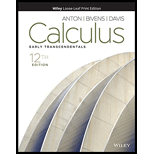
Concept explainers
Evaluate the derivative.
(a)
(b)
(c)
(d)
Want to see the full answer?
Check out a sample textbook solution
Chapter 3 Solutions
Calculus: Early Transcendentals, Enhanced Etext
Additional Math Textbook Solutions
Probability And Statistical Inference (10th Edition)
Elementary Statistics
University Calculus: Early Transcendentals (4th Edition)
Intro Stats, Books a la Carte Edition (5th Edition)
- Differentiate the following functionarrow_forwardA box with a square base and open top must have a volume of 13,500 cm³. Find the dimensions that minimise the amount of material used. Ensure you show your working to demonstrate that it is a minimum.arrow_forwardConsider the equation, f(x) = x*. (a) Using the trapezoidal method with 3 columns, estimate the value of the integral f² f(x)dx. (b) Using the trapezoidal method with 10 columns, estimate the value of the integral f² f(x)dx. You many need software to help you do this (e.g. MATLAB, Excel, Google sheets). (c) Use software to accurately calculate the integral (e.g. Wolfram alpha, Matlab). Using this answer, comment on the answers you found in parts a) and b).arrow_forward
- Question 1. (10 points) A researcher is studying tumours in mice. The growth rate for the volume of the tumour V(t) in cm³ is given by dV = 1.45V(2 In(V+1)). dt (a) (4 pts) Find all the equilibria and determine their stability using the stability condition. (b) (2 pts) Draw the phase plot f(V) versus V where f(V) = V'. You may find it helpful to use Desmos or Wolfram Alpha to plot the graph of f(V) versus V (both are free to use online), or you can plot it by hand if you like. On the plot identify each equilibrium as stable or unstable. (c) (4 pts) Draw direction arrows for the case where the tumour starts at size 3cm³ and for the case where the tumour starts at size 9cm³. Explain in biological terms what happens to the size of each of these tumours at time progresses.arrow_forwardFor the system consisting of the two planes:plane 1: -x + y + z = 0plane 2: 3x + y + 3z = 0a) Are the planes parallel and/or coincident? Justify your answer. What does this tell you about the solution to the system?b) Solve the system (if possible). Show a complete solution. If there is a line of intersection express it in parametric form.arrow_forwardQuestion 2: (10 points) Evaluate the definite integral. Use the following form of the definition of the integral to evaluate the integral: Theorem: Iff is integrable on [a, b], then where Ax = (ba)/n and x₂ = a + i^x. You might need the following formulas. IM³ L² (3x² (3x²+2x- 2x - 1)dx. n [f(z)dz lim f(x)Az a n→∞ i=1 n(n + 1) 2 n i=1 n(n+1)(2n+1) 6arrow_forward
- For the system consisting of the three planes:plane 1: -4x + 4y - 2z = -8plane 2: 2x + 2y + 4z = 20plane 3: -2x - 3y + z = -1a) Are any of the planes parallel and/or coincident? Justify your answer.b) Determine if the normals are coplanar. What does this tell you about the system?c) Solve the system if possible. Show a complete solution (do not use matrix operations). Classify the system using the terms: consistent, inconsistent, dependent and/or independent.arrow_forwardFor the system consisting of the three planes:plane 1: -4x + 4y - 2z = -8plane 2: 2x + 2y + 4z = 20plane 3: -2x - 3y + z = -1a) Are any of the planes parallel and/or coincident? Justify your answer.b) Determine if the normals are coplanar. What does this tell you about the system?c) Solve the system if possible. Show a complete solution (do not use matrix operations). Classify the system using the terms: consistent, inconsistent, dependent and/or independent.arrow_forwardOpen your tool box and find geometric methods, symmetries of even and odd functions and the evaluation theorem. Use these to calculate the following definite integrals. Note that you should not use Riemann sums for this problem. (a) (4 pts) (b) (2 pts) 3 S³ 0 3-x+9-dz x3 + sin(x) x4 + cos(x) dx (c) (4 pts) L 1-|x|dxarrow_forward
 Calculus: Early TranscendentalsCalculusISBN:9781285741550Author:James StewartPublisher:Cengage Learning
Calculus: Early TranscendentalsCalculusISBN:9781285741550Author:James StewartPublisher:Cengage Learning Thomas' Calculus (14th Edition)CalculusISBN:9780134438986Author:Joel R. Hass, Christopher E. Heil, Maurice D. WeirPublisher:PEARSON
Thomas' Calculus (14th Edition)CalculusISBN:9780134438986Author:Joel R. Hass, Christopher E. Heil, Maurice D. WeirPublisher:PEARSON Calculus: Early Transcendentals (3rd Edition)CalculusISBN:9780134763644Author:William L. Briggs, Lyle Cochran, Bernard Gillett, Eric SchulzPublisher:PEARSON
Calculus: Early Transcendentals (3rd Edition)CalculusISBN:9780134763644Author:William L. Briggs, Lyle Cochran, Bernard Gillett, Eric SchulzPublisher:PEARSON Calculus: Early TranscendentalsCalculusISBN:9781319050740Author:Jon Rogawski, Colin Adams, Robert FranzosaPublisher:W. H. Freeman
Calculus: Early TranscendentalsCalculusISBN:9781319050740Author:Jon Rogawski, Colin Adams, Robert FranzosaPublisher:W. H. Freeman
 Calculus: Early Transcendental FunctionsCalculusISBN:9781337552516Author:Ron Larson, Bruce H. EdwardsPublisher:Cengage Learning
Calculus: Early Transcendental FunctionsCalculusISBN:9781337552516Author:Ron Larson, Bruce H. EdwardsPublisher:Cengage Learning





